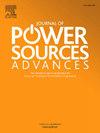Li-ion battery voltage curve reconstruction using partial charge profiles: Actual v/s truncated data
IF 4.6
Q2 CHEMISTRY, PHYSICAL
引用次数: 0
Abstract
Voltage reconstruction is a common technique used in estimation of degradation modes for aged Li-ion batteries. For real-life implementation, it is desirable for voltage reconstruction to work for partial charging as real-life batteries are rarely charged fully. In this pursuit, the presented work investigates a common practice of using truncated data from full charge as a representation of partial charging in voltage reconstruction. Usage of truncated data is prevalent despite known deviations between data collected from partial and full charge cycles and has resulted in a misconception that accurate voltage reconstruction is achievable using partial charging data. Therefore, voltage reconstruction errors between models parametrised using truncated data and actual partial charging data were compared. Results show a four-fold increase in error when using truncated data, which indicates that truncated data is an inappropriate proxy of partial charge. The findings also imply that partial charging is a limitation of voltage reconstruction modelling not highlighted before due to usage of truncated data. This limitation must be addressed to improve the applicability of voltage reconstruction. The study also emphasises the need to generate new battery degradation datasets with appropriate inclusion of partial charging data to enable the development of accurate and holistic models.
使用局部充电曲线重建锂离子电池电压曲线:实际v/s截断数据
电压重构是估计老化锂离子电池退化模式的常用技术。在现实生活中,由于现实生活中的电池很少充满电,因此希望电压重构能够在部分充电时工作。在这一追求中,提出的工作调查了在电压重建中使用完全充电截断数据作为部分充电表示的常见做法。尽管从部分充电周期和完全充电周期收集的数据之间存在已知偏差,但截短数据的使用仍然很普遍,这导致了一种误解,即使用部分充电数据可以实现精确的电压重建。因此,比较了截断数据参数化模型与实际部分充电数据的电压重构误差。结果表明,截断后的数据误差增加了4倍,这表明截断后的数据不适合作为部分电荷的代表。研究结果还表明,部分充电是电压重建模型的限制,由于使用截断的数据,之前没有强调。为了提高电压重构的适用性,必须解决这一限制。该研究还强调需要生成新的电池退化数据集,其中适当包括部分充电数据,以便开发准确和全面的模型。
本文章由计算机程序翻译,如有差异,请以英文原文为准。
求助全文
约1分钟内获得全文
求助全文

 求助内容:
求助内容: 应助结果提醒方式:
应助结果提醒方式:


